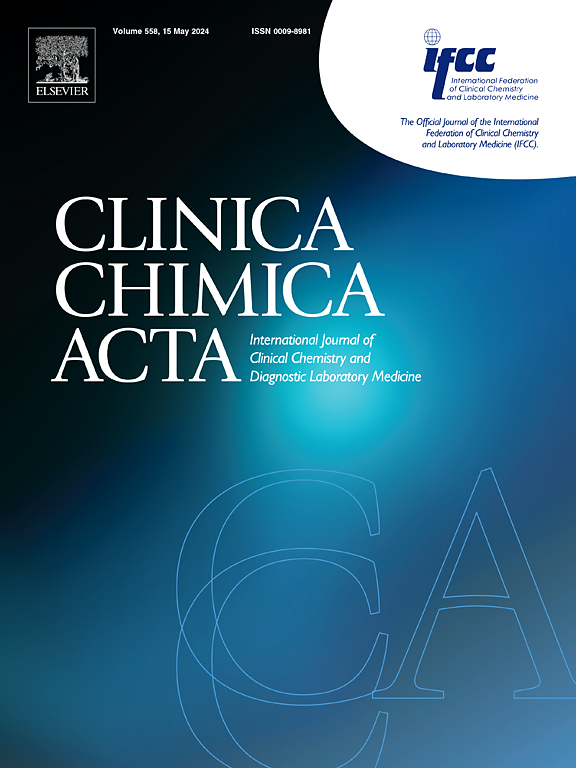Co-occurrence of congenital isolated FSH deficiency and androgen-secreting steroid cell tumour in a Chinese female – Intermittent menses in a patient with primary amenorrhoea
IF 2.9
3区 医学
Q2 MEDICAL LABORATORY TECHNOLOGY
引用次数: 0
Abstract
Background
Congenital isolated FSH deficiency is a rare autosomal recessive disorder characterized by primary amenorrhoea, absent or partial breast development, infertility, undetectable serum FSH, and pathogenic variant detected in FSHB gene. Ovarian steroid cell tumour is another rare disease entity that can present in the young, with features of androgenic, estrogenic, or cortisol excess. To date, there have been no reports of the two disease entities occurring in a single patient.
Case report
A Chinese female presented with primary amenorrhoea and undetectable serum FSH at the age of 16. She developed spontaneous menses intriguingly at the age of 19, with elevated serum testosterone, leading to subsequent diagnosis of right ovarian steroid cell tumour, not otherwise specified (NOS). After surgical resection, the patient redeveloped amenorrhoea, along with normalized testosterone and undetectable estradiol. Sequencing of FSHB gene revealed homozygosity of a novel variant c.366C > A p.(Cys122*), which is predicted to disrupt FSH heterodimer formation.
Literature review and discussion
Literature and case reports on congenital isolated FSH deficiency and steroid cell tumours published in English language were reviewed. The common involvement of gonadotropins and sex steroids by the two pathologies raises the suspicion of possible disease linkage.
Conclusion
We herein report the first case of steroid cell tumour identified in a Chinese female with isolated FSH deficiency. The unique presentation of primary amenorrhoea, spontaneous menses, and secondary amenorrhoea post-surgery highlights the role of peripheral aromatization in FSH deficiency. Co-occurrence of the two rare disease entities may help uncover the role of FSH, inhibin, and LH in ovarian tumorigenesis.
中国女性先天性孤立性卵泡刺激素缺乏和雄激素分泌类固醇细胞肿瘤的共同发生——原发性闭经患者间歇性月经。
背景:先天性孤立性卵泡刺激素缺乏症是一种罕见的常染色体隐性遗传病,其特征为原发性闭经、乳房缺失或部分发育、不孕症、血清卵泡刺激素检测不到、FSHB基因检测到致病性变异。卵巢类固醇细胞瘤是另一种罕见的疾病,可在年轻人中出现,具有雄激素、雌激素或皮质醇过量的特征。迄今为止,还没有这两种疾病实体发生在单个患者身上的报告。病例报告:一名中国女性,16岁时出现原发性闭经和血清FSH检测不出。她在19岁时出现自发性月经,血清睾酮升高,导致随后诊断为右侧卵巢类固醇细胞瘤,未另行说明(NOS)。手术切除后,患者再次出现闭经,同时睾酮恢复正常,雌二醇未检出。FSHB基因测序显示,一个新变异c.366C > a p.(Cys122*)具有纯合性,预计该变异会破坏FSH异源二聚体的形成。文献回顾与讨论:回顾了以英文发表的关于先天性孤立性卵泡刺激素缺乏和类固醇细胞肿瘤的文献和病例报告。促性腺激素和性类固醇在这两种病理中的共同作用引起了对可能的疾病联系的怀疑。结论:我们在此报告一例分离性卵泡刺激素缺乏的中国女性类固醇细胞瘤。原发性闭经、自发性月经和术后继发性闭经的独特表现突出了外周芳构化在FSH缺乏中的作用。这两种罕见疾病的共同发生可能有助于揭示FSH、抑制素和LH在卵巢肿瘤发生中的作用。
本文章由计算机程序翻译,如有差异,请以英文原文为准。
求助全文
约1分钟内获得全文
求助全文
来源期刊

Clinica Chimica Acta
医学-医学实验技术
CiteScore
10.10
自引率
2.00%
发文量
1268
审稿时长
23 days
期刊介绍:
The Official Journal of the International Federation of Clinical Chemistry and Laboratory Medicine (IFCC)
Clinica Chimica Acta is a high-quality journal which publishes original Research Communications in the field of clinical chemistry and laboratory medicine, defined as the diagnostic application of chemistry, biochemistry, immunochemistry, biochemical aspects of hematology, toxicology, and molecular biology to the study of human disease in body fluids and cells.
The objective of the journal is to publish novel information leading to a better understanding of biological mechanisms of human diseases, their prevention, diagnosis, and patient management. Reports of an applied clinical character are also welcome. Papers concerned with normal metabolic processes or with constituents of normal cells or body fluids, such as reports of experimental or clinical studies in animals, are only considered when they are clearly and directly relevant to human disease. Evaluation of commercial products have a low priority for publication, unless they are novel or represent a technological breakthrough. Studies dealing with effects of drugs and natural products and studies dealing with the redox status in various diseases are not within the journal''s scope. Development and evaluation of novel analytical methodologies where applicable to diagnostic clinical chemistry and laboratory medicine, including point-of-care testing, and topics on laboratory management and informatics will also be considered. Studies focused on emerging diagnostic technologies and (big) data analysis procedures including digitalization, mobile Health, and artificial Intelligence applied to Laboratory Medicine are also of interest.
 求助内容:
求助内容: 应助结果提醒方式:
应助结果提醒方式:


